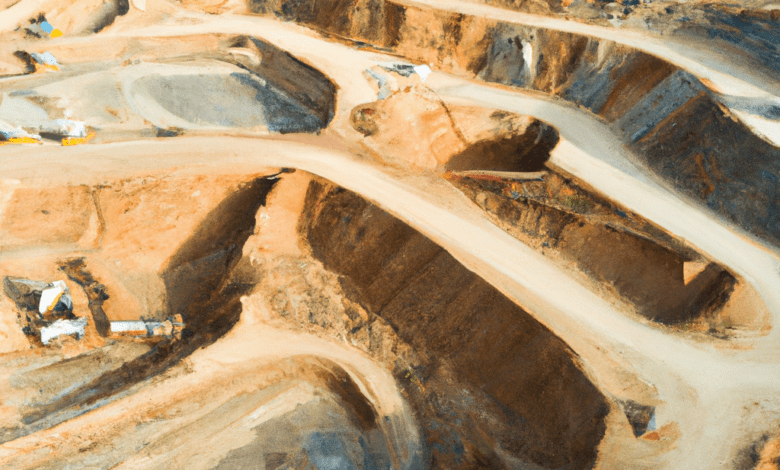Digging Deeper: The Ripple Effect of Mining Regulations on Metal Prices

In an era where environmental sustainability and resource management are at the forefront of global discussions, the mining industry finds itself at a pivotal crossroads. Mining regulations, once viewed primarily as bureaucratic hurdles, have emerged as significant players in shaping market dynamics and influencing the valuation of metals. As governments worldwide implement new laws aimed at reducing environmental impact and promoting sustainable practices, the ripple effects on metal prices are profound and multifaceted. This article delves into the intricate relationship between mining regulations and metal prices, exploring how regulatory shifts can reshape market landscapes, the direct correlation between mining restrictions and the valuation of raw materials, and the resultant price volatility that ensues in commodity markets. By examining these interconnected elements, we aim to shed light on the complex interplay between regulatory frameworks and the economic forces that drive metal pricing in today’s ever-evolving market.
- 1. **"Regulatory Shifts: How New Mining Laws Influence Market Dynamics"**
- 2. **"From the Ground Up: The Relationship Between Mining Restrictions and Metal Valuation"**
- 3. **"Price Volatility: Analyzing the Correlation Between Regulatory Changes and Commodity Markets"**
1. **"Regulatory Shifts: How New Mining Laws Influence Market Dynamics"**
Regulatory shifts in the mining sector can have profound implications for market dynamics, particularly concerning metal prices. When governments introduce new mining laws or amend existing regulations, they can significantly alter the landscape of production and investment within the industry. For instance, stricter environmental regulations may lead to increased operational costs for mining companies, as they invest in cleaner technologies and compliance measures. This can decrease the supply of metals in the market, leading to upward pressure on prices, especially for commodities with inelastic demand.
Conversely, the easing of regulations can stimulate production by making it more economically viable for companies to explore and extract resources. Increased output can flood the market with a surplus of metals, which may result in a decline in prices. The balance of these regulatory frameworks often reflects broader economic conditions and governmental priorities, such as sustainability initiatives or infrastructure development. For example, a government focused on attracting foreign investment may implement more business-friendly policies, thereby encouraging exploration and production but potentially compromising environmental standards.
Furthermore, regulatory shifts can also impact investor sentiment. Uncertainty surrounding potential changes in mining laws can deter investment in the sector, leading to reduced capital availability for mining projects. This hesitance can stymie new discoveries and development, which, over time, can constrict supply and drive up prices. Additionally, regions that are perceived as politically stable with transparent regulatory frameworks may attract more investment, solidifying their positions as key players in the global mining landscape.
In summary, the interplay between mining regulations and metal prices is complex and multifaceted. Changes in legislation not only influence the immediate operational costs and supply capabilities of mining companies but also shape broader market perceptions and investment flows, ultimately affecting the pricing of metals on a global scale. As such, stakeholders must remain vigilant to regulatory developments, as they can be pivotal in determining market trajectories.
2. **"From the Ground Up: The Relationship Between Mining Restrictions and Metal Valuation"**
The intricate relationship between mining regulations and metal valuation is a crucial area of focus within the commodities market. When governments implement stricter mining restrictions—whether for environmental protection, social responsibility, or resource management—these regulations can significantly alter the supply dynamics of various metals.
As mining operations face heightened compliance costs and operational limitations, the immediate effect is often a reduction in the available supply of metals. For instance, regulations that require more extensive environmental assessments, or those that mandate the rehabilitation of mining sites, can delay project timelines and increase the costs associated with extraction. This reduction in supply can create upward pressure on metal prices, as demand remains constant or continues to grow in sectors such as construction, electronics, and renewable energy technologies.
Moreover, regulatory uncertainty can deter new investments in mining projects. Investors typically seek stable environments where the rules governing resource extraction are clear and predictable. When mining regulations shift unpredictably, potential investors may withdraw or delay investment, exacerbating supply constraints. Such scenarios can result in price volatility, particularly for metals that are already subject to fluctuating demand due to their cyclical nature or emerging market trends.
On the other hand, the imposition of mining regulations can also lead to improved practices within the industry. Stricter requirements can foster innovation in mining technologies and processes, promoting more efficient extraction methods and reducing environmental impact. Over time, these advancements may stabilize or even lower production costs, potentially affecting metal prices in the long term.
In summary, the relationship between mining restrictions and metal valuation is multifaceted. While stricter regulations can lead to immediate supply constraints and price increases, they can also inspire innovation and sustainability within the sector. Understanding this dynamic is essential for stakeholders, including investors, policymakers, and industry professionals, as they navigate the complex interplay between regulation and market forces in the mining industry.
3. **"Price Volatility: Analyzing the Correlation Between Regulatory Changes and Commodity Markets"**
The relationship between mining regulations and price volatility in commodity markets is a complex interplay influenced by various factors, including geopolitical considerations, market demand, and the inherent characteristics of the metals involved. Regulatory changes can lead to significant fluctuations in metal prices, as they directly impact supply dynamics. For instance, the introduction of stricter environmental regulations may lead to increased operational costs for mining companies, which can result in reduced production levels. When supply diminishes, prices often rise in response to the scarcity of the commodity.
Conversely, deregulation or the easing of restrictions can have the opposite effect. Increased mining activity and production capacity can flood the market with metals, leading to a decrease in prices. This was evident in regions where governments have relaxed mining laws to attract foreign investment or boost local economies. Such regulatory shifts can create a ripple effect across the commodity markets, as traders and investors adjust their strategies based on anticipated supply changes.
Moreover, the timing and perception of regulatory changes play a crucial role in shaping market reactions. Announcements of new regulations can lead to immediate price spikes or drops, depending on market sentiment and the perceived severity of the changes. Traders often react not only to the regulations themselves but also to the uncertainty they create. This uncertainty can lead to speculative trading, further exacerbating price volatility.
The correlation between regulatory changes and commodity prices is also evident in the context of global supply chains. For example, regulations in one country can influence prices in another, particularly for metals that are traded internationally. A mining regulation imposed in a major producing country can shift market dynamics globally, affecting prices in markets far removed from the regulatory change itself.
Ultimately, the analysis of price volatility in response to mining regulations reveals a multifaceted relationship that underscores the importance of regulatory stability for market predictability. Understanding this correlation is crucial for stakeholders—ranging from investors to policymakers—who seek to navigate the complexities of the commodity markets in an era of evolving regulatory landscapes. As governments worldwide continue to balance economic interests with environmental and social responsibilities, the implications of regulatory changes on metal prices will remain a critical area of observation and analysis.
In conclusion, the intricate relationship between mining regulations and metal prices underscores the significant role that policy frameworks play in shaping market dynamics. As highlighted in our exploration of regulatory shifts, new mining laws can lead to both opportunities and challenges for the industry, ultimately influencing supply levels and, consequently, metal valuations. The analysis of mining restrictions reveals a clear correlation between regulatory environments and the pricing of commodities, with stricter regulations often leading to supply constraints that drive prices higher. Moreover, the volatility observed in metal markets in response to policy changes emphasizes the need for stakeholders to remain vigilant and adaptable in the face of evolving regulations. As the global demand for metals continues to grow alongside technological advancements and sustainability initiatives, the importance of a balanced regulatory approach cannot be overstated. Policymakers must strive to create frameworks that ensure environmental protection while promoting industry growth, fostering stability in metal prices, and ultimately benefiting both producers and consumers alike. As we move forward, understanding and navigating the impacts of mining regulations will be crucial for all participants in the metal market landscape.





